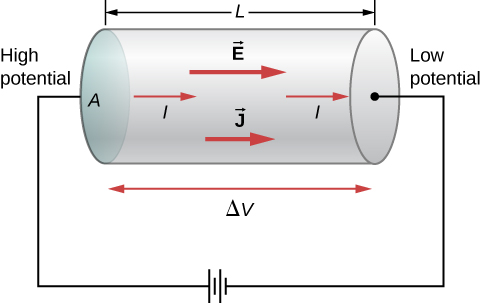| << Chapter < Page | Chapter >> Page > |
View this interactive simulation to see what the effects of the cross-sectional area, the length, and the resistivity of a wire are on the resistance of a conductor. Adjust the variables using slide bars and see if the resistance becomes smaller or larger.
Looking back at [link] , you will see a column labeled “Temperature Coefficient.” The resistivity of some materials has a strong temperature dependence. In some materials, such as copper, the resistivity increases with increasing temperature. In fact, in most conducting metals, the resistivity increases with increasing temperature. The increasing temperature causes increased vibrations of the atoms in the lattice structure of the metals, which impede the motion of the electrons. In other materials, such as carbon, the resistivity decreases with increasing temperature. In many materials, the dependence is approximately linear and can be modeled using a linear equation:
where is the resistivity of the material at temperature T , is the temperature coefficient of the material, and is the resistivity at , usually taken as .
Note also that the temperature coefficient is negative for the semiconductors listed in [link] , meaning that their resistivity decreases with increasing temperature. They become better conductors at higher temperature, because increased thermal agitation increases the number of free charges available to carry current. This property of decreasing with temperature is also related to the type and amount of impurities present in the semiconductors.
We now consider the resistance of a wire or component. The resistance is a measure of how difficult it is to pass current through a wire or component. Resistance depends on the resistivity. The resistivity is a characteristic of the material used to fabricate a wire or other electrical component, whereas the resistance is a characteristic of the wire or component.
To calculate the resistance, consider a section of conducting wire with cross-sectional area A , length L , and resistivity A battery is connected across the conductor, providing a potential difference across it ( [link] ). The potential difference produces an electrical field that is proportional to the current density, according to .

The magnitude of the electrical field across the segment of the conductor is equal to the voltage divided by the length, , and the magnitude of the current density is equal to the current divided by the cross-sectional area, Using this information and recalling that the electrical field is proportional to the resistivity and the current density, we can see that the voltage is proportional to the current:
The ratio of the voltage to the current is defined as the resistance R :
The resistance of a cylindrical segment of a conductor is equal to the resistivity of the material times the length divided by the area:

Notification Switch
Would you like to follow the 'University physics volume 2' conversation and receive update notifications?